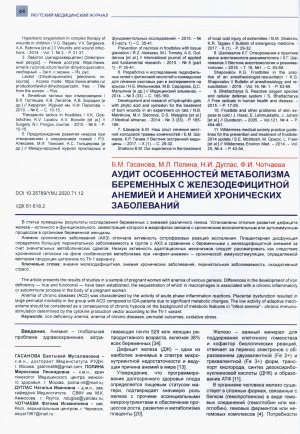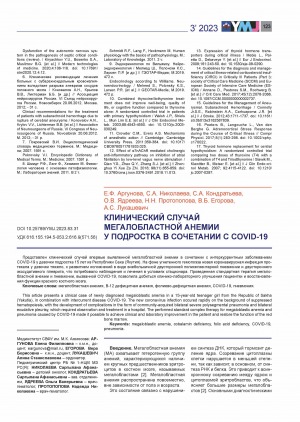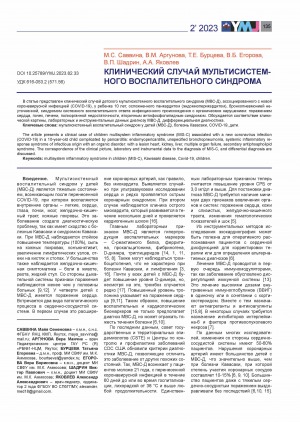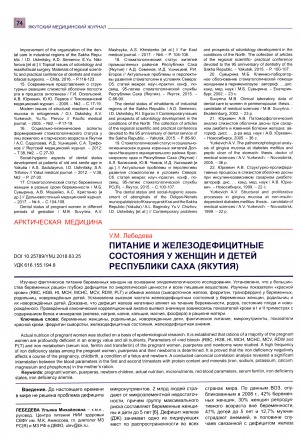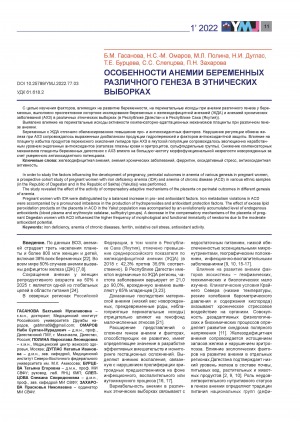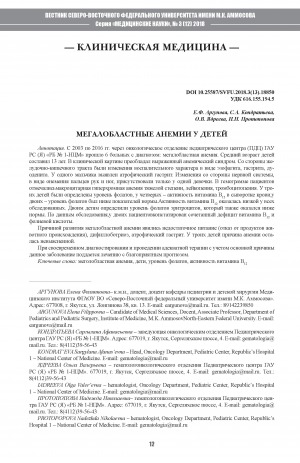
Клинический случай синдрома Пирсона у ребенка в Республике Саха (Якутия) = A clinical case of pearson syndrome in a child in the Sakha Republic (Yakutia)
Статья в журнале
Русский
616.15-006-053.2(571.56)
10.25587/2587-5590-2024-2-70-75
синдром Пирсона; новорожденные; дети раннего возраста; митохондриопатия; анемия; лактатацидоз; мультисистемное поражение; гематология; неврология; педиатрия; Pearson syndrome; newborns; early age children; mitochondriopathy; anemia; lactic acidosis; multisystem damage; hematology; neurology; pediatrics
Медицина и здравоохранение / Клиническая медицина / Педиатрия
Pearson syndrome (PS) is a rare multisystem disease with predominant involvement of the hematopoietic organs, pancreas and liver, developing due to a defect in mitochondrial DNA. Most often, the first clinical manifestations of Pearson syndrome in the form of anemia of varying severity appear in the first year of life. The disease was first described in 1979 by Howard Pearson, who included in this syndrome sideroblastic anemia, vacuolation of hematopoietic progenitor cells in the bone marrow, exocrine pancreatic dysfunction, and early onset of the disease, usually before the age of 1 year. According to the literature, the incidence of Pearson syndrome is 1:5000. This article presents a clinical case of a boy diagnosed with Pearson syndrome at the age of 6 months. The child had pale skin from birth and a general blood test showed severe anemia. In the myelogram: Moderate increase in proliferation of the erythroid germ with impaired maturation, diserythro and dysmegakaryocytopoiesis, moderate monocytosis, ring-shaped sideroblasts 45 %. In a molecular genetic study: on DNA material isolated from the patient’s blood cells and urinary sediment using the polymerase chain reaction of very long fragments, the patient was analyzed for the presence of mitochondrial DNA deletions in the region where most of the major changes were described (m.6380-m. 16567). DNA isolated from the patient’s blood cells and urine sediment revealed a deletion of about 3000 bp. in a homoplasmic state. The boy also has neurological disorders. Currently, the child is admitted monthly to the oncology department of the pediatric center for replacement therapy with blood components. He has been observed by hematologists together with neurologists. He also receives chelation therapy and methylprednisolone therapy on an ongoing basis. For anticonvulsant purposes: vigabatrin. Symptomatic therapy, according to the recommendations of the federal center: Courses of Riboflavin, Tocopherol (vitamin E), Coenzyme Q, Succinic acid, L-carnitine, Thiamine.
Клинический случай синдрома Пирсона у ребенка в Республике Саха (Якутия) / О. В. Ядреева, Е. М. Харабаева, В. Б. Егорова [и др.] ; ГАУ РС (Я) "Республиканская больница N 1 им. М. Е. Николаева", Северо-Восточный федеральный университет им. М. К. Аммосова, Медицинский институт // Вестник Северо-Восточного федерального университета им. М. К. Аммосова. Серия: Медицинские науки. - 2024. - N 2 (35). - C. 70-75. - DOI: 10.25587/2587-5590-2024-2-70-75
DOI: 10.25587/2587-5590-2024-2-70-75
Войдите в систему, чтобы открыть документ
